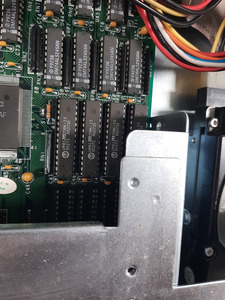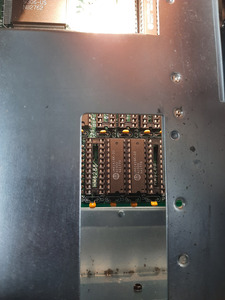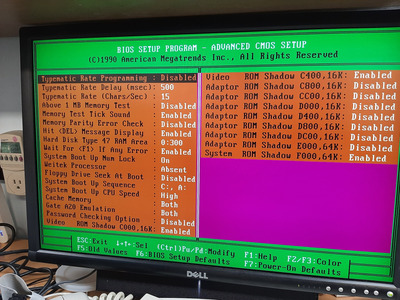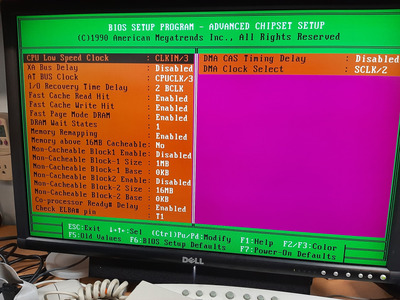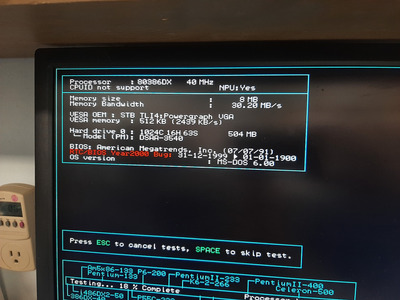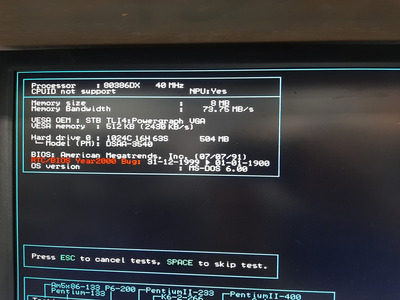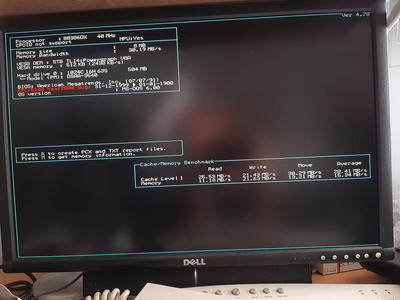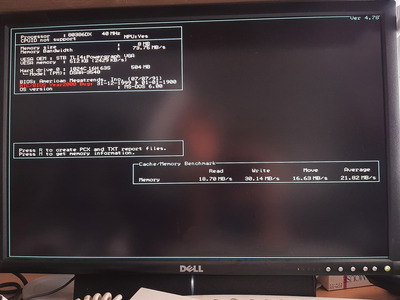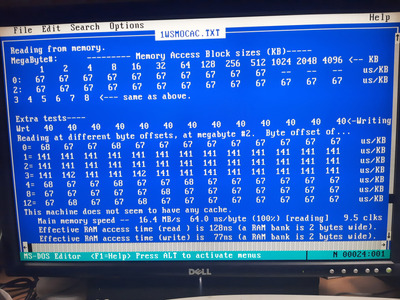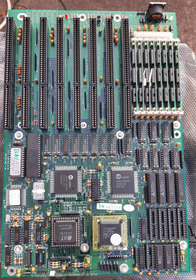Thanks Deunan for the info and baseline to test against. I ran with 128K cache enabled and 1ws and got this..
CACHECHK V7 11/23/98 Copyright (c) 1995-98 by Ray Van Tassle. (-h for help)
CMOS reports: conv_mem= 640K, ext_mem= 7,424K, Total RAM= 8,064K
386 Clocked at 39.0 MHz
Reading from memory.
MegaByte#: --------- Memory Access Block sizes (KB)-----
1 2 4 8 16 32 64 128 256 512 1024 2048 4096 <-- KB
0: 39 39 39 39 39 39 39 39 90 90 -- -- -- us/KB
2: 39 39 39 39 39 40 40 40 90 90 90 90 90 us/KB
3 4 5 <--- same as above.
6: 39 39 39 39 39 40 40 39 90 90 90 90 -- us/KB
7: 39 39 39 39 39 40 40 40 90 90 90 -- -- us/KB
8: 39 39 39 39 39 40 40 39 90 -- -- -- -- us/KB
Extra tests----
Wrt 47 47 47 47 47 47 47 47 47 47 47 47 47<-Writing
Reading at different byte offsets, at megabyte #2. Byte offset of...
0= 39 39 39 39 39 40 40 40 90 90 90 90 90 us/KB
1= 79 79 79 79 79 79 80 79 128 128 128 128 128 us/KB
2= 79 79 79 79 79 79 79 79 129 128 128 128 128 us/KB
3= 79 79 79 79 80 79 79 80 128 128 128 128 128 us/KB
4= 39 40 39 39 39 40 40 40 90 90 90 90 90 us/KB
8= 39 39 39 39 40 40 40 40 90 90 90 90 90 us/KB
12= 39 39 39 40 39 40 40 40 90 90 90 90 90 us/KB
This machine seems to have one cache!? [reading]
!! cache is 128KB-- 27.9 MB/s 37.6 ns/byte (228%)
>>>> If you think you do have L2 cache, you might have FAKE CACHE chips! <<<<
5.6 clks
Main memory speed -- 12.2 MB/s 85.8 ns/byte (100%) [reading] 12.8 clks
Effective RAM access time (read ) is 171ns (a RAM bank is 2 bytes wide).
Effective RAM access time (write) is 89ns (a RAM bank is 2 bytes wide).
386 Clocked at 39.0 MHz. Cache ENABLED.
Options: -t0 -z
Disabling cache and enabling 0ws resulted in this..
CACHECHK V7 11/23/98 Copyright (c) 1995-98 by Ray Van Tassle. (-h for help)
CMOS reports: conv_mem= 640K, ext_mem= 7,424K, Total RAM= 8,064K
386 Clocked at 39.0 MHz
Reading from memory.
MegaByte#: --------- Memory Access Block sizes (KB)-----
1 2 4 8 16 32 64 128 256 512 1024 2048 4096 <-- KB
0: 54 54 54 54 54 54 54 54 54 54 -- -- -- us/KB
2: 54 54 54 54 54 54 54 54 54 54 54 54 54 us/KB
3 4 5 6 7 8 <--- same as above.
Extra tests----
Wrt 33 33 33 33 33 33 33 33 34 33 33 33 33<-Writing
Reading at different byte offsets, at megabyte #2. Byte offset of...
0= 54 54 54 54 54 54 54 54 54 54 54 54 54 us/KB
1= 113 113 113 113 113 113 113 113 113 113 113 113 113 us/KB
2= 113 113 113 114 113 113 113 113 113 113 113 113 113 us/KB
3= 114 113 113 113 113 113 113 113 113 113 113 113 113 us/KB
4= 54 54 54 54 54 54 54 54 54 54 54 54 54 us/KB
8= 54 54 54 54 54 54 54 54 54 54 54 54 54 us/KB
12= 54 54 54 54 54 54 54 54 54 54 54 54 54 us/KB
This machine does not seem to have any cache.
Main memory speed -- 20.4 MB/s 51.3 ns/byte (100%) [reading] 7.6 clks
Effective RAM access time (read ) is 102ns (a RAM bank is 2 bytes wide).
Effective RAM access time (write) is 63ns (a RAM bank is 2 bytes wide).
386 Clocked at 39.0 MHz. Cache ENABLED.
Options: -t0 -z
I tried disabling the fast read and write hits and it didn't change anything unfortunately. It seems like the /3 on the bus has been running okay, but time may tell for the hard drive corruption. Had to swap out several I/O cards til I found one that worked well enough at that speed. I also have the option to go down to /2 on the bus, but I haven't had any luck getting that stable. On a whim I set the divider up to 5 but that didn't help @ 0ws.
